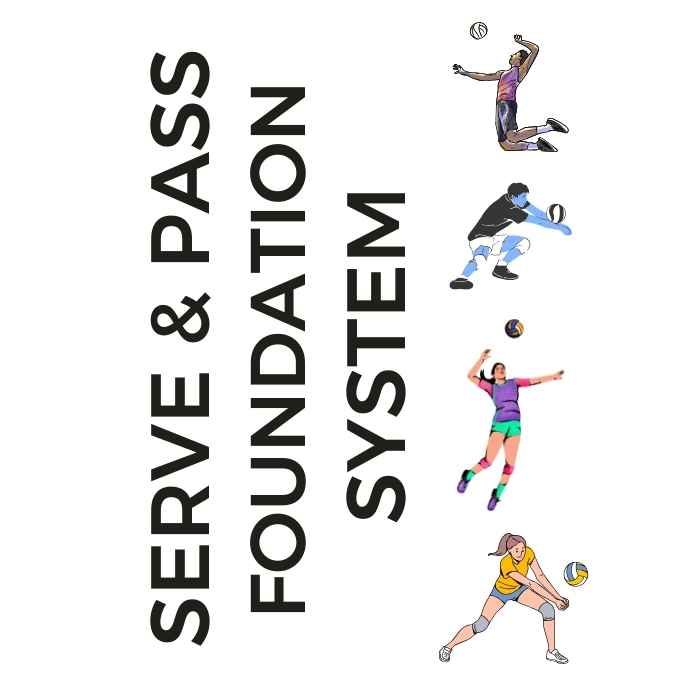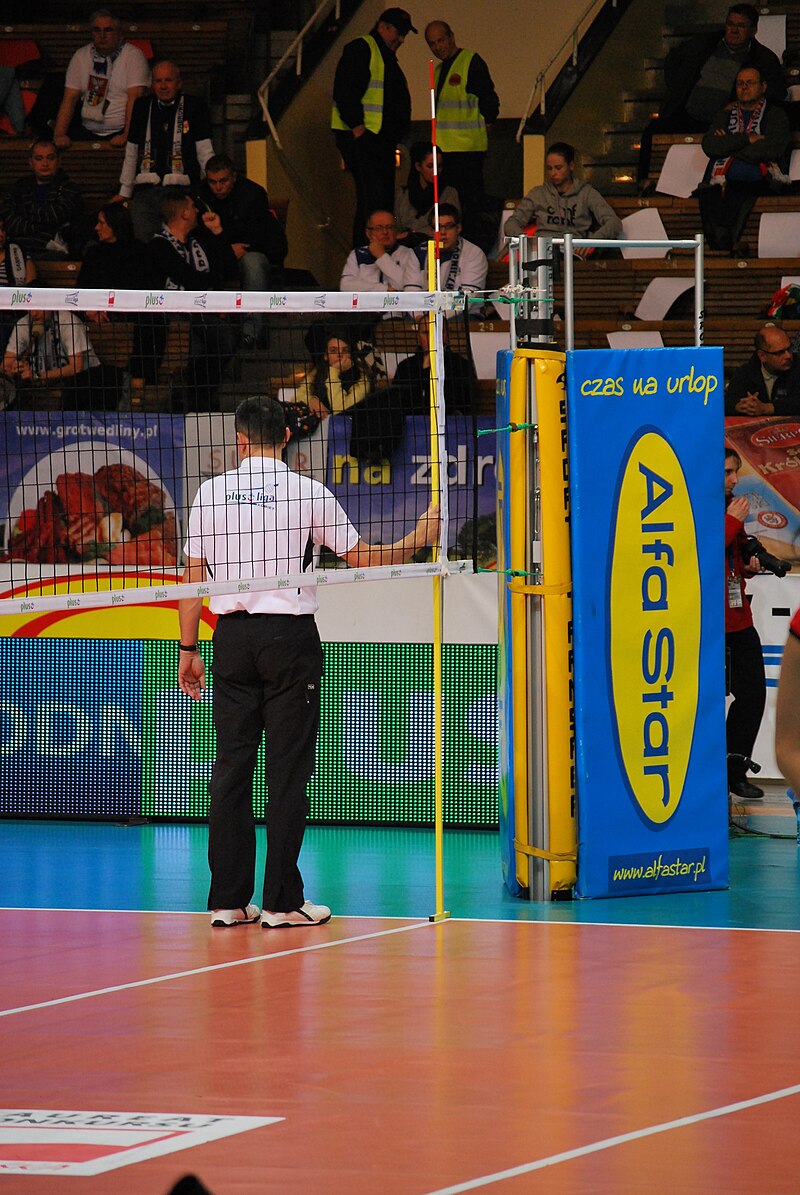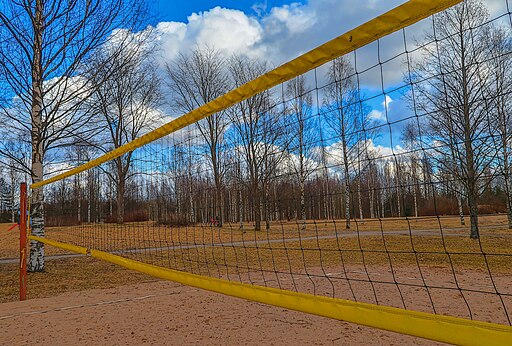
Serve + Pass Foundation System: The Complete Skills Arsenal The two-skill mastery system that transforms inconsistent players into the athletes coaches build their lineups around. Stop Struggling With The Two Most Important Skills In Volleyball!
- Improve Your Volleyball with Coach April
- Volleyball Court Size
What's The Volleyball Court Size? Volleyball Basics For Beginners
The volleyball court size changes with varying disciplines of the sport. This basic volleyball info describes the official size and height for each discipline.
Setting up your own practice space?
These portable volleyball court boundary lines make it easy to practice anywhere.
Had to put that sunset in there...isn't that a gorgeous background behind the beach net?
The official indoor volleyball court size in American measuring units is 29'6" by 29 feet and six inches for the half court area.
The full volleyball court area is 59 feet x 29' 6".
If you were using the metric system then the half court area is 9 meters by 9 meters while the entire court is 18 meters long by 9 meters wide.
Many people like to round these numbers up to 30 feet by 60 feet but the accurate measurements are the ones I stated and are indicated in the diagram above.
The above measurements are the same for both the men's and women's volleyball court size.
Setting up your own practice space?
These portable volleyball court boundary lines make it easy to practice anywhere.
If you were to play on a girl's court and then go play on a guy's court, although the net is higher on the guy's court, the volleyball court size, which means the length and width of the court, would be the same.
Once you know the dimensions of the court you should learn of some of the other interesting characteristics concerning the volleyball court size which is defined by the court lines and are usually painted in contrasting colors on the competition floor.
Speaking of court sizes check out what happens on the University of Florida court during pre-game team introductions in the video below.
Since #NCAAVB went with court projection intros, we'll just leave this #TBT here pic.twitter.com/zSv9dDIkqZ
— Gators Volleyball (@GatorsVB) December 15, 2017
How To Measure Volleyball Court Size
The lines that border the court edges which serve to define the court size are two inches wide.
To accurately measure the boundary lines you start measuring from inside of the court lines.
You'd take your tape measure or ruler and place it on the part of the line closest to the court playing area to measure two inches wide for an accurate reading.
Remember two inches is equal to five centimeters.
The Lines That Define Court Size
The volleyball court size is defined by four boundary lines, the two longest ones are called "sidelines."
These run lengthwise or along the long side of the court and they are both perpendicular to the net.
Volleyball court sidelines should be two inches wide and are highlighted in the diagram below by the red parallel lines running along the longer sides of the rectangle.
The other two lines on the opposite ends are end lines.
- The endlines connect to the sidelines on the shorter sides of the rectangle.
- The endlines are parallel to the net and to the ten foot lines.
The ten foot lines on each court half, separate the front court from the back court.
Court end lines are two inches wide and are highlighted in the diagram below by the red parallel lines on the shorter sides of the rectangle.
The area surrounding the outside of the court is called the free zone. It has a minimum width of six feet six inches or two meters.
This is the area located between the court and the team bench, and surrounds the entire court area where players safely enter to play a ball back into the court without interference.
The center line which runs underneath the net is another boundary line which separates the two half courts from each other.
Outdoor Court Size
For years in outdoor competition on the sand, the beach volleyball court size was the same as the indoor court which was 30 feet by 60 feet.
In 2001, in a controversial move the FIVB voted to minimize the volleyball court size for outdoor doubles sand competition to a much shorter size of 8 meters by 16 meters for men and women.
A year later, the AVP, the Association of Volleyball Professionals did the same thing.
The rationale behind the move was to make the beach game more interesting, faster and competitive for television audiences.
For the same reasons the libero volleyball position was introduced in indoor volleyball, the outdoor volleyball court was made smaller because television audiences around the world had proven to be more attracted to the defensive game and not just the power game that was a trademark of the men's way of playing.
As far as sand depth is concerned, the sand in the court has to be 12 inches deep.
The Sitting Volleyball Court Size
In sitting volleyball, the official court size is 10 meters by 6 meters.
The Nine Man Volleyball Court Size
The court size for the nine man game is 33 feet long and 33 feet wide. The net is taller at 7 feet and 8.5 inches high.
You should become familiar with the court and all of its components for example, the antennas, the front court, back court, official court size, the net, court lines and you should know the correct net height.
Now that you know what the court sizes are - grab my step-by-step advanced passing checklist used by my private training clients.
The Official Court Size - Quick Review
The court size from one end to the other is basically 60 feet by 30 feet, give or take a few inches.
I think, specifically its 59 feet and a few inches by 29 feet and a few inches, but you can check out this volleyball court diagram.
There's a centerline that measures two inches wide and goes from sideline to sideline which divides the two playing courts into two 29 foot 6 inch halves where the teams play, one on one side and the opposing team on the other.
This centerline is a contrasting color so that it's plainly visible to players and referees most importantly as it stretches underneath the net.
Frequently Asked Volleyball Questions About The Volleyball Court Size
1. What is the standard volleyball court size?
- The standard indoor volleyball court size is 29'6" by 59 feet, with a net height of 7 feet 11 5/8 inches (for men) or 7 feet 4 1/8 inches (for women). Outdoor court sizes can vary but are generally the same as indoor courts.
2. How do I measure a volleyball court?
- To measure a volleyball court, start by measuring the length and width of the court according to the official dimensions. The boundary lines should be two inches wide and should be measured from the inside of the court lines.
 To measure a volleyball court, start by measuring the length and width of the court according to the official dimensions. (Photo by zorro2212)
To measure a volleyball court, start by measuring the length and width of the court according to the official dimensions. (Photo by zorro2212)3. Can the volleyball court size vary for different levels of play?
- Yes, the volleyball court size can vary for different levels of play. For example, youth and recreational leagues may use smaller court sizes while professional and international competitions adhere to the standard court size.
4. Are there any specific lines on a volleyball court?
- Yes, a volleyball court has several lines that define specific areas. The sideline lines run along the long sides of the court, while the end lines run parallel to the net on the shorter sides. The centerline divides the court into two equal halves.
5. Can the court size for beach volleyball be different?
- Yes, the beach volleyball court size can be different. The standard size for beach doubles competition is 16 meters by 8 meters (52.5 feet by 26.25 feet). This smaller court size allows for a faster and more dynamic game.
6. Is there a specific court size for sitting volleyball?
- Yes, the official court size for sitting volleyball is 10 meters by 6 meters (32.8 feet by 19.7 feet). This modified court size accommodates players who are sitting during the game.
7. What are the dimensions of the net in volleyball?
- The standard net height for men's volleyball is 7 feet 11 5/8 inches, and for women's volleyball, it is 7 feet 4 1/8 inches. The net should be 39 inches wide and positioned vertically in the center of the court.
8. Can the court size affect the game strategy?
- Yes, the court size can influence the game strategy. A smaller court size may require more precise ball placement and quicker reactions, while a larger court may allow for more defensive coverage and longer rallies.
9. Are there any regulations regarding the free zone around the court?
- Yes, the free zone surrounding the outside of the court must have a minimum width of six feet six inches or two meters. This space provides players with a safe area to enter and exit the court without interfering with the game.
10. Are there any specific rules or court dimensions for nine-man volleyball?
- Yes, nine-man volleyball has its own court size and rules. The court size for nine-man volleyball is 33 feet long and 33 feet wide, with a taller net height of 7 feet 8.5 inches. The game is played with nine players on each team, allowing for larger teams and unique strategies.
Building Your Own Volleyball Court: Options for Home Practice
Now that you understand the official volleyball court dimensions and requirements, you might be considering creating a practice space at home.
As a volleyball coach, I've seen how having access to proper training facilities can make a huge difference in a player's development.
Whether you have a spacious backyard, a garage, or are interested in installing a sand court, there are professional-grade solutions available that can transform your space into a valuable training facility. Let's explore the essential equipment needed to create a proper practice court that meets regulation standards.
Court Boundary Line Systems
Using the proper court boundaries are essential for realistic practice and game simulation.
Modern boundary line systems offer easy setup and professional-grade visibility, helping players develop proper spatial awareness during training.
Key Considerations:
- Visibility and contrast
- Weather resistance
- Setup convenience
- Anchoring system
- Storage solution
Top Recommended Boundary Systems
1. Premium Court Line Kits ($50-100+)
"For permanent or semi-permanent court setups:"
- Sport Court Pro Boundary Line Kit
* High-visibility straps
* Heavy-duty stakes
* Quick-adjust corners
* Carrying case included
* Weather-resistant materials
2. Adjustable Volleyball Training Lines ($30-50)
"Perfect for multiple court configurations:"
- Wilson Outdoor Volleyball Court Lines
* Easy setup design
* Includes corner anchors
* Adjustable for beach or grass
* Compact storage
3. Beach Volleyball Line Kits ($25-40)
"Ideal for sand court setups:"
- Park & Sun Sports Beach Court Lines
* UV-resistant straps
* Sand stakes included
* High visibility in sand
* Includes corner markers
My Pro Tip: Consider purchasing two sets of boundary lines if you plan to set up courts on different surfaces (sand vs. grass) especially if you're planning to host a tournament. This saves time switching between locations and extends the life of your equipment.
Smart Seasonal Shopping for Volleyball Court Equipment
Making Your Investment Count: My Final Recommendations
Dear volleyball mom, creating a home volleyball practice space is a significant investment in your player's development.
When planning your court setup, consider starting with these essential packages:
Premium Package ($700-1000+):
Perfect for serious club players and year-round training:
- Professional-grade portable system
- Competition-level net
- Premium boundary line kit
- Total investment provides years of reliable training
Mid-Range Package ($400-600):
Ideal for regular practice and skill development:
- Mid-range complete court system
- Separate professional net
- Adjustable training lines
- Excellent value for committed players
Starter Package ($200-300):
Great for beginning players and recreational use:
- Basic portable system with included net
- Standard boundary lines
- Perfect for evaluating long-term commitment
My Pro Coach Tips:
- Consider your available space and surface type before purchasing
- Factor in storage requirements for equipment
- Remember to budget for safety padding if installing near hard surfaces
- Think about lighting needs for evening practice sessions
- Consider purchasing during off-season for better deals
Investment Protection:
To maximize the lifespan of your volleyball court equipment:
- Store indoor equipment when not in use
- Use weather covers for permanent outdoor setups
- Regularly check and maintain tension systems
- Keep spare boundary stakes and anchors on hand
Remember!
The best volleyball court setup is one that gets used regularly.
Choose equipment that matches your commitment level and makes setup easy enough to encourage frequent practice sessions.
Volleyball Court Size:
Where Do You Go From Here?
Good times! Where do you need to go now? Here are three options:
- Learn more about the Court Size and Court Measurements.
- Follow the suggested reading on our Sitemap page Learning How To Play (Sitemap)
- Or visit the pages in the Volleyball Rules section in the drop down menu at the top of the page.
If your athlete struggles with consistent serve receive, gets subbed out, or is overlooked for playing time—this is the fix you’ve been looking for.

Struggling with passing consistency?
I help talented passers tired of getting pulled from games because of inconsistent serve receive skills BUILD passing confidence without expensive private lessons using the same 3-step system that's helped dozens of my athletes get recruited.
Download my eBook for $17.99 and start building the passing confidence that keeps you on the court—and gets you seen by college coaches.
From Lady Vol to Legend: Coach April Produces Powerful Passionate Players...is that you?
What Are You Looking For?
Click to Download Your Pre Serving Ritual Mastery Checklist pdf:
🎯Volleyball Pre Serving Ritual Guide -
Players! Learn How To Transform Your Serve from Weak to Weapon
Click to Download Your Parent's Volleyball Serving Checklist pdf
🎯Parent's Volleyball Serving Checklist Guide
Parents! Help Your Player Develop Championship Serves (Even If You've Never Played)

Hi there!
Thanks for stopping by. Hope you learned something today that will help you reach your volleyball goals.
Be sure to subscribe to my email newsletter so you can learn more each week!
Stay strong! Stay motivated!
-Coach April

SUSCRIBE to my email newsletter below!
 Click to learn more about the weekly volleyball classes and clinics or email info@imrpoveyourvolley.com for information
Click to learn more about the weekly volleyball classes and clinics or email info@imrpoveyourvolley.com for informationCongratulations to my seven Boys-18s Vegas Volley club players who played in two state championship finals yesterday, the 3A and 5A State champinship finals at Sunrise Mountain High School.
TOURNAMENT CHAMPIONS!
A-1 Vegas Volley VBC
In It To Win It Tournament
May 2 - 4, 2025 Tournament
Gold Medalists
18s Premier Division
Vegas Volleyball's Unsung Heroes: Celebrating Moms with Peace Love Volleyball Shirts
Ready to energize your volleyball mom journey?
Subscribe to my 'Producing Powerful Passionate Peaceful Players' email list above on ImproveYourVolley.com.
You'll receive energy-boosting tips, exclusive insights from me, Coach April Chapple on maintaining momentum in volleyball.
Let's power up the Vegas volleyball scene together!
Recent Articles
-
5 Essential Serving Tips from Tennessee's #2 Career Aces Record Holder
Dec 09, 25 11:01 AM
I've identified the 5 essential serving tips that separate confident servers from struggling ones and you'll serve with the confidence that creates aces -
The Volleyball Toss How Consistent Is Your Ball Toss Before You Serve?
Dec 07, 25 12:29 AM
The volleyball toss for the overhand serve needs to consistently be two feet up in the air and one foot in front of front foot which puts the ball in front of your serving arm. -
Shop Small: Real Volleyball Training With + Results From A Real Coach
Dec 03, 25 10:30 AM
Support a woman-owned business. Get training from a former elite pro with 13+ years coaching experience. Ditch the big box store--invest in proven results.
Bestselling
Volleyball Nets
on Sale!














































